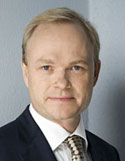 Stig Gustavson |
Rising demand for industrial raw materials may be putting pressure on tyre prices, but it is one of the factors fuelling growth for Konecranes' heavy lifting equipment.
The global equipment manufacturer saw sales in its heavy lifting segment more than double in three years from EUR214.1 million (USD 328.2 million) in 2004 to EUR549 million (USD841.6 million) in 2007. Konecranes' heavy lifting business area produces heavy-capacity forklifts, process cranes, ship-to-shore cranes, rubber-tyred and rail-mounted gantry cranes, reach stackers and straddle carriers.
Konecranes says in its 2007 annual report that market growth in its heavy lifting business was driven by the growth, rationalisation and relocation of process-type industries and increasing world trade with growing freight volumes.
According to the report, growth in the sector has also been fuelled by globalisation, the rising need for industrial raw materials, increasing energy demand, environmental issues, the booming shipbuilding industry and strong economic growth in developing economies like Russia and China.
Konecranes chairman of the board Stig Gustavson says in his annual report message that while 2007 was a successful year for the company, Konecranes' share price dropped significantly. It peaked at an all-time-high of EUR34.90 (USD53.50) on 13 July 2007 but by the end of 2007, the value was EUR23.58 (USD36.15), almost the same as a year earlier.
Gustavson says the company's stock performance was related to "external factors" and not the company's performance.
"We have good reason to believe in a continuing strong stock performance as we have seen before in spite of the difficulties during the autumn."
 Pekka Lundmark |
Company president Pekka Lundmark agrees: "The turbulence on the financial markets in the second half of 2007 did not seem to impact on our demand. Our 27% growth in new orders exceeded the 18% sales growth, which means that we start 2008 with an order book 32.6% stronger than a year ago. These promising numbers indicate continued growth in 2008."
Gustavson says Asian trade is no longer dominated by links between the US and China, so lower US demand for Chinese exports will not mean lower Chinese demand for European-made production machinery.
He adds that Konecranes' strong presence in the US market is not "necessarily risky" in an economic downturn.
"Over half of our US sales is related to service. Along with a depreciating dollar, many US industry sectors find new opportunities in export markets. Our company, being an early cyclical, can already feel this trend. Our US organisation also finds new opportunities in South America."
Cranes, forklifts and key crane components like trolleys are assembled at the company's manufacturing sites in Finland, Sweden, China, the UK and US. The products' components are sourced globally including from manufacturing partners in Poland, Slovakia, Ukraine, Estonia, China and Thailand.
Konecranes' heavy lifting business area recorded sales of EUR549 million (USD842 million) for calendar year 2007, 11.8% higher than 2006's EUR490.8 million (USD752.3 million). The group's total sales was EUR1.750 billion (USD2.683 billion), 18% higher than 2006's EUR1.483 billion (USD2.273 billion) while net profit was EUR129.2 million (USD198.1 million), 88.3% higher than 2006's EUR68.6 million (USD105.2 million).